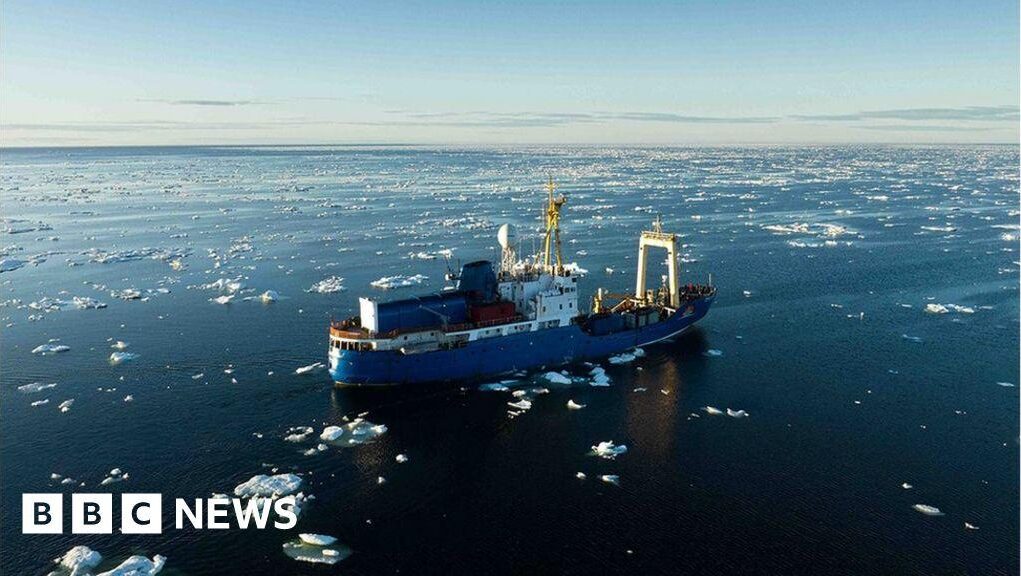A massive search and rescue effort is under way in the North Atlantic after a submarine exploring the wreck of the Titanic went missing on Sunday.
The research vessel Polar Prince lost contact with the crew of the Titan sub an hour and 45 minutes into its dive. The US Coast Guard estimated the sub had between 70 and 96 hours of emergency oxygen, as of 17:00 EST (22:00 BST) on Monday.
Tour firm OceanGate said it was exploring all options to get the crew back safely, and government agencies have joined the rescue operation. Here is what we know so far.
The Polar Prince arrived near the location of the Titanic wreck in the Atlantic Ocean on Sunday morning. A Facebook post from Hamish Harding, who was on the Titan, said they expected to start the dive in the submersible at 0400 local time.
The Boston Coast Guard, which is leading the search operation, said on Twitter that the five person crew “submerged Sunday morning, and the crew of the Polar Prince lost contact with them approximately one hour and 45 minutes into the vessel’s dive”.
The Titan submarine was thought to be approximately 900 miles (1450km) off the coast Cape Cod at the time.
The US Coast Guard’s Rear Admiral John Mauger said on Monday that it is a challenge to conduct a search in such a remote area.
This video can not be played
Watch: Titanic tourist sub search ‘a challenge’ – Rear Adm John Mauger
The search has two aspects, he said. These are a surface search in case the Titan returned to the ocean’s surface but somehow lost communications, and an underwater sonar search.
The Coast Guard has sent two C-130 Hercules aircraft to search for the submersible on the surface of the water, and has been joined by a Canadian C-130, and a P8 aircraft equipped with underwater sonar capability.
Rear Adm Mauger said that they would need additional expertise to rescue the vessel if it was found underwater and were reaching out for help, including to the US Navy.
Canada’s defence department said that, along with the aircraft, the Canadian coast guard vessel Kopit Hopson was assisting in the search.
Horizon Maritime, which co-owns the Polar Prince, confirmed to the BBC that vessel is helping and a second vessel, the Horizon Arctic, has been sent to the site.
Among the five people on board the Titan, only one name has been confirmed – Hamish Harding, a 59-year-old British billionaire businessman and explorer.
Mr Harding first announced he was joining the team in June last year, and said that the crew on the vessel includes “a couple of legendary explorers, some of which have done over 30 dives to the RMS Titanic since the 1980s”.
He is the chairman of Action Aviation, an international company which is deals with sales and operations in the business aviation industry, based in Dubai, United Arab Emirates.
On Twitter, his firm said on Sunday that “the sub had a successful launch and Hamish is currently diving”.
On Monday, the US Coast Guard said it was not ready to confirm the identities of those on board out of respect for their families.
OceanGate Expeditions charges guests $250,000 (£195,270) for a place on its eight-day expedition to see the famous wreck, which sits 3,800m (12,500ft) beneath the surface at the bottom of the Atlantic.
The site is about 600km (370 miles) off the coast of Newfoundland, and lies in two parts, with the bow and the stern separated by about 800m (2,600ft). A huge debris field surrounds the broken vessel.
A full dive to the wreck, including the descent and ascent, reportedly takes eight hours.
Each expedition lasts eight days, according to OceanGate, and each dive is meant to include a scientific objective, including studying the wreck’s decay.
The inaugural dive took place in 2021, according to the company’s website.
The Titan is a five-person submersible built to descend to depths of 4,000 metres (2.5 miles) and travels at three knots – that’s about 3.5 miles per hour.
Aside from taking divers to the wreck of the Titanic, it’s used for site survey and inspection, research and data collection, film and media production, and deep sea testing of hardware and software.
According to the company, the Titan is “outfitted with state-of-the-art lighting and sonar navigation systems plus internally and externally mounted 4K video and photographic equipment”.
According to OceanGate’s website, the five-person sub has system for monitoring the vessel’s hull in real time.
It has sensors to analyse the effects of changing pressure on the sub as it dives, in order to assess the integrity of the structure.
“This onboard health analysis monitoring system provides early warning detection for the pilot with enough time to arrest the descent and safely return to surface,” the company says.
The BBC’s US partner CBS sent one of its reporters on a voyage with the same company last year to see the wreck of the Titanic.
David Pogue, who went on board, reported that he read a waiver that described the submersible as an “experimental” vessel, “that has not been approved or certified by any regulatory body, and could result in physical injury, disability, emotional trauma or death”.
OceanGate CEO Stockton Rush then gave him a tour of the submersible, where he revealed the vessel only has one button and is run using a video game controller.
Missing Titanic sub may have 70 hours of oxygen left
British adventurer among missing on Titanic sub
Scans of Titanic reveal wreck as never seen before








